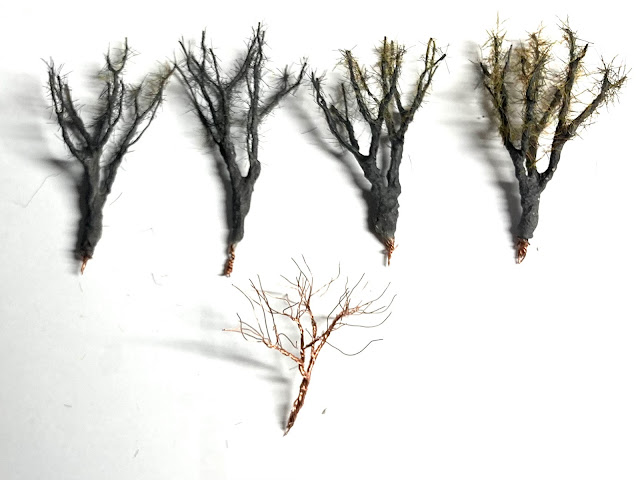My continued interest in the practice of modelling trees has recently been focused upon a particular style, a scene I wanted to evoke - the straggly sort of low trees that are found along river banks and estuaries where water logged soil and an exposed site means thin and short trees fight for existence with their brethren...
In particular I had a desire to model these in winter. Leafless, their form of mingled tangled branches reaching for the sky evokes a sort of natural desolation that only goes to underline a cold bleak winters day - the muse for my most recent of cameo topics.
"Right" I thought, "I know what to do, I'll use my copper wire that I've used previously in both OO and N and just make the trees shorter and less comple". The results (above) looked promising in their raw form. These are twisted from strands of copper untwisted from 45A cable (used for wiring car batteries). They have formed the basis of all my tree experiments in recent years...
...yet here, they felt clumsy, especially with the N gauge DMU. "No problem", I thought. "I'll add some static grass fibres to their tips to add twigs" (below). Sadly this did little to improve matters, only making the transition from the copper wire to static fibre even more prominent.
No what Ineeded was more finesse.
I have always avoided using standard household cable flex for tree making, expecting it's copper filaments to be so thin to not hold their shape without the risk of regular damage - but after trawling the internet, scenic modelling shops and YouTube I was drawing a blank on any other options.
Curiosity got the better of me, and as I knew there was a short off cut in my electrical bits box I cut off the insulation material and separated out the strands. This wasn't a long length, but it was too long for what I had mind so I halved it - and then combined the bunch of individual strands into one, twisting together the base for about 1cm length. This was then paired and twisted, paired and twisted until I had just single filaments - the last step was to use tweezers to tweak and bend these strands to point upwards.
Now we're getting somewhere (below, at the bottom).
I used PVA on the trunk to smooth out the 'twists' and to give it some strength before a waft of dark grey etch primer, and things were still looking promising so I went on to a production line! The result (below) is about an hour of TV watching whilst twisting. A further hour on PVA and priming - so two hours for about 12 winter trees - all shorted than 5cm!
They're not bad posed individually, but what I wanted was that tangled mess and when overlapped and mingled, placed close together on the layout the result was just as I had hoped. Yes, there are no twigs, and the branches are a little too uniform in thickness - yes in places you can see where I've twisted the filaments - but as a whole, the composition works. The method gives me the feeling I was looking for - from here it's about refining this for a future work - for now, this small slice of winter will break cover in the coming weeks.
I hope this encourages you all to have a go at this sort of craft yourself. Whilst 'shake the box' or complete trees are available from a variety of excellent suppliers, just like ballasting, I find the art of tree making one of the unsung heroes of the hobbies impact on my mental heath. Until next time, more soon...
Donate
I love writing and creating material for the blog. If you enjoy what you read and engage with I would be appreciative of any donation, large or small, to help me keep it advert and restriction free.





The joy of successful iteration. I also found it a mindful experience to form the small number of trees I've had a go at, perhaps not with the same level of finesse but hopefully practice makes better. With any luck it won't be too long until all my house-moving boxes have been emptied out onto shelves so I can lay my hands on my supplies and join you in this quest for armature finesse.
ReplyDeleteThanks James. It is nice when a plan comes together - this although documented here in one page, was, as you know a few weeks of work and thinking. Pleased to have a way forward.
Deletelove how these trees turned out
ReplyDeleteThank you, I’m really pleased with these too, a real triumph of perseverance!
Delete